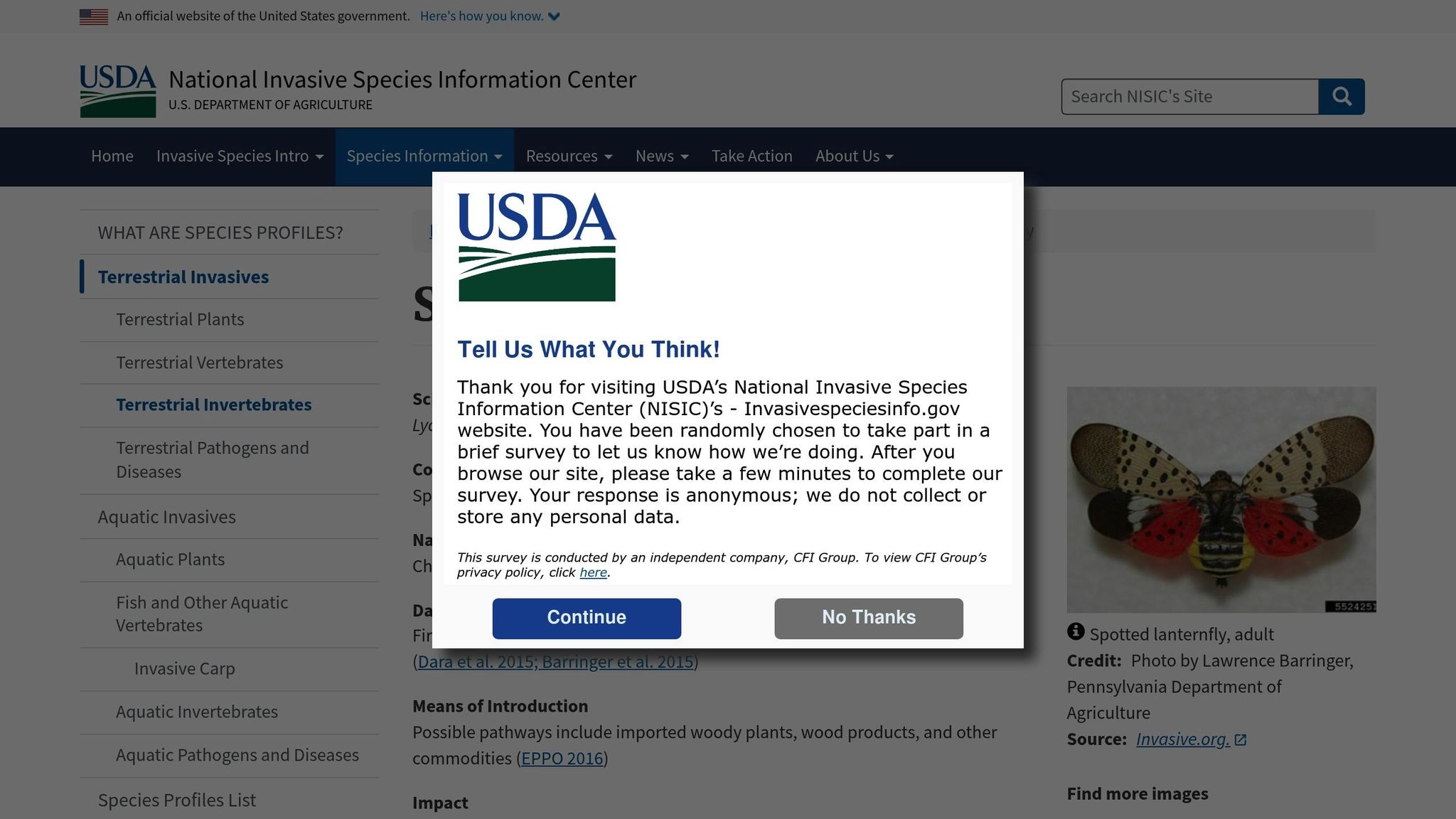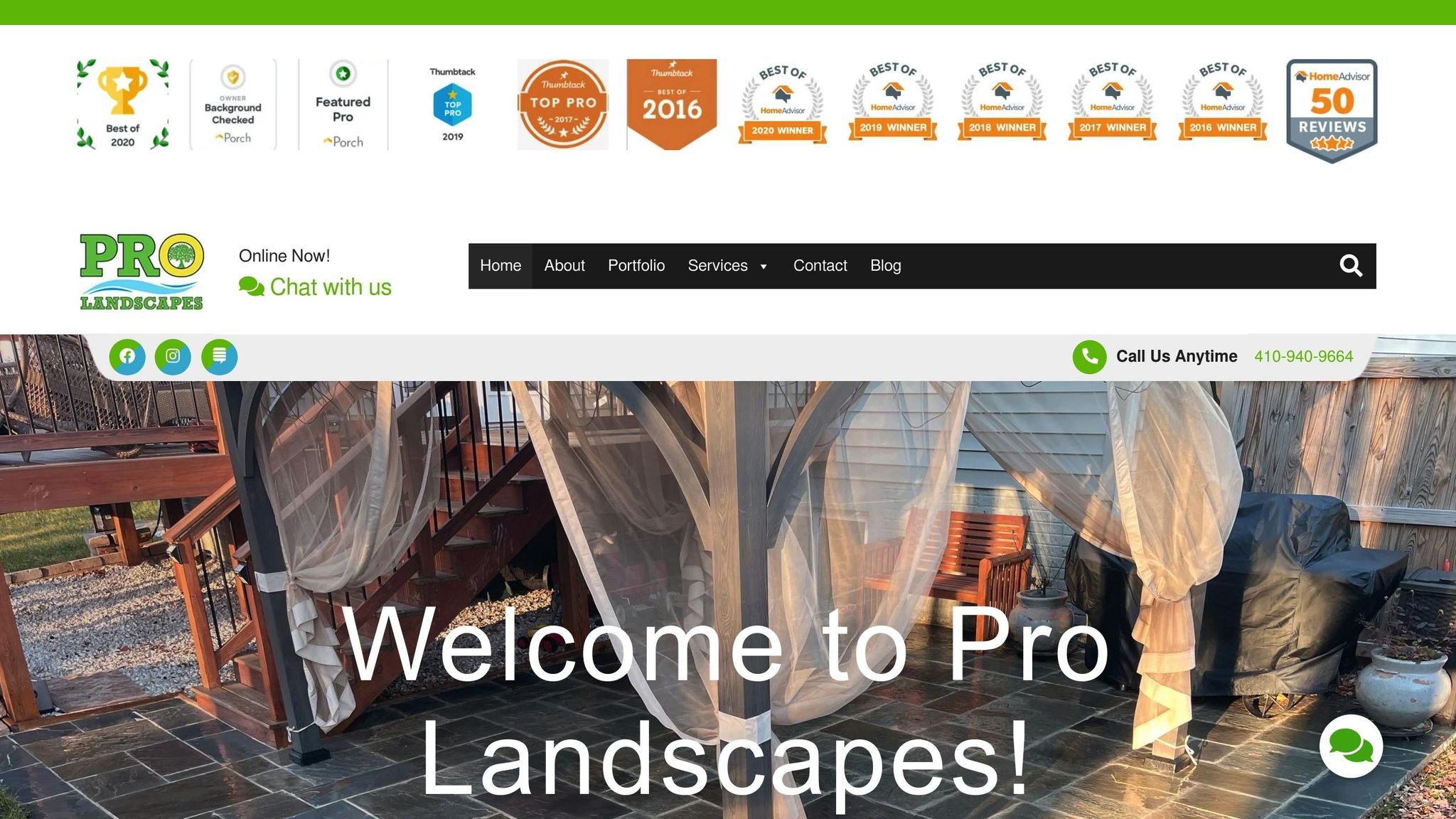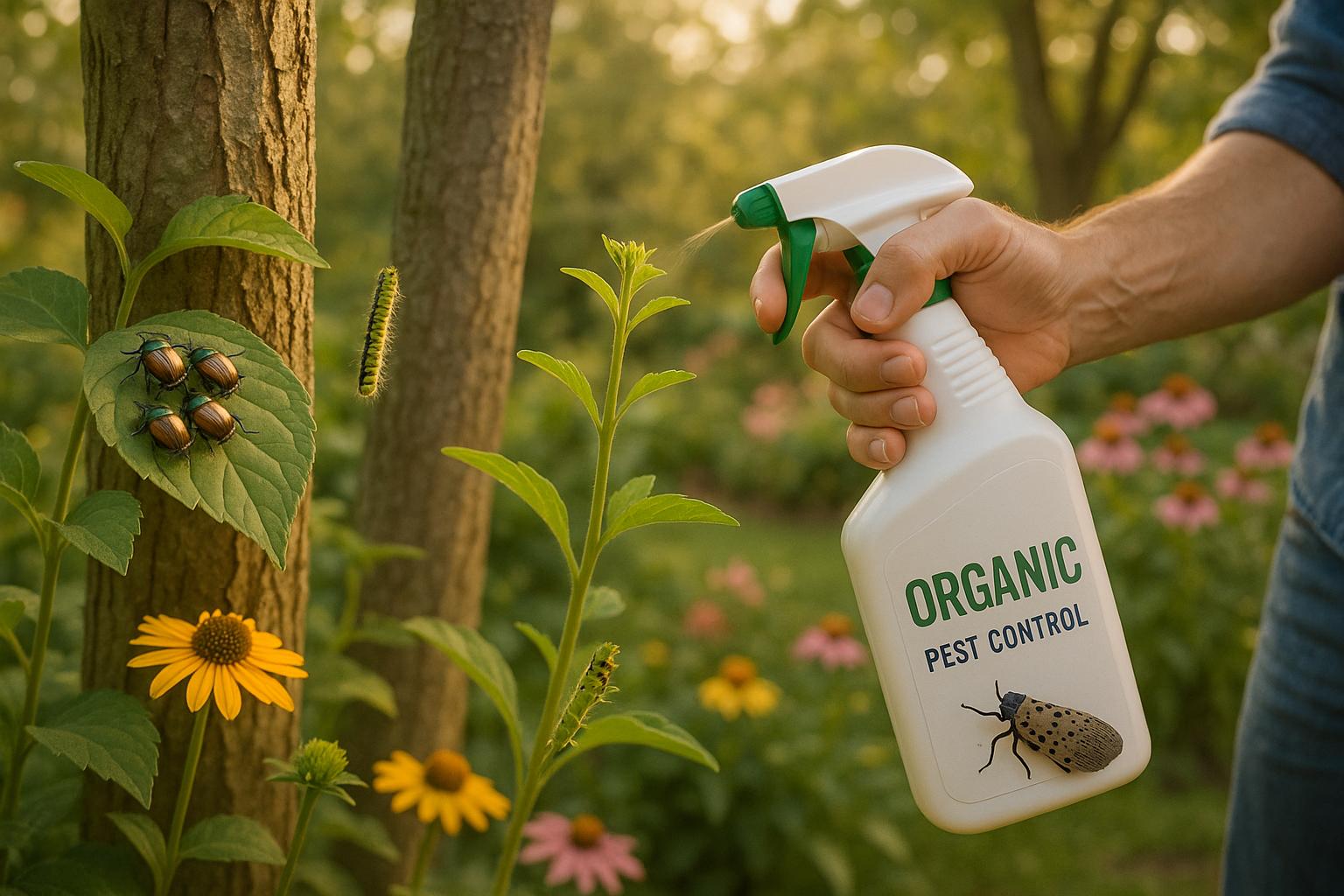- bhavya gada
- No Comments
Pests like white grubs, stink bugs, and spotted lanternflies can damage your lawn, trees, and plants. Integrated Pest Management (IPM) offers a balanced approach to control these pests while protecting the environment. Here’s what you need to know:
- Common Maryland Pests: White grubs harm grass roots, stink bugs damage fruits and plants, and ambrosia beetles attack stressed trees.
- IPM Basics: Combine healthy plant care, natural pest predators, and selective pesticide use.
- Prevention Tips: Improve drainage, plant pest-resistant species, and maintain proper soil pH.
- Natural Pest Control: Attract helpful insects like lady beetles and parasitic wasps to keep pests in check.
- Professional Help: Experts provide tailored solutions, including pest inspections, targeted treatments, and landscape adjustments.
Quick Tip: Regular monitoring and early action are key to keeping your yard healthy and pest-free. Learn how IPM can work for your property.
Integrated Pest Management IPM Basics
Major Pests in Maryland Yards
Maryland’s lush landscapes are home to various pests that can wreak havoc on residential properties. Knowing what these pests are and how they behave is key to managing them effectively.
White Grubs
White grubs, the larvae of beetles, are notorious for feeding on grass roots, especially during late summer and early fall. Their damage often shows up as brown, spongy patches in your lawn. If your turf feels soft underfoot and can be rolled back like a carpet, chances are you’ll find these grubs feasting on the roots just below the surface.
Stink Bugs
Brown marmorated stink bugs are a common nuisance, targeting ornamental trees, vegetables, and fruit trees from spring through fall. They use their piercing mouthparts to feed, leaving behind small, discolored spots on fruits and leaves. Over time, this feeding can cause misshapen growth and weaken plants significantly.
Ambrosia Beetles
Ambrosia beetles are tiny wood-boring insects that become active in early spring. A clear sign of their presence is the appearance of fine sawdust "toothpicks" protruding from small holes in tree trunks. These beetles typically attack stressed or weakened trees, carving out intricate tunnels in the wood, which can lead to branch dieback and, eventually, the death of the tree.
Scale Insects
Scale insects are a persistent problem for Maryland’s ornamental plants and trees. These small, stationary pests attach themselves to branches, twigs, and leaves, often resembling tiny bumps. By sucking sap from the plant, they cause yellowing leaves, stunted growth, and even branch dieback. Common types of scale insects in Maryland include:
- Magnolia scale
- Tuliptree scale
- Japanese maple scale
- Euonymus scale
Spotted Lanternfly

The spotted lanternfly is a serious threat to trees and vines, particularly the Tree of Heaven (Ailanthus altissima). Signs of infestation include sap oozing from tree trunks, black sooty mold caused by honeydew, wilting branches, and large groups of the insects clustering on trees. Their activity often indicates plant stress and poor drainage, making early detection crucial for managing their impact.
Identifying these pests is the first step in implementing effective Integrated Pest Management (IPM) strategies to protect your yard.
IPM Methods for Maryland Properties
Integrated Pest Management (IPM) helps tackle pest problems in Maryland while minimizing harm to the surrounding environment.
Plant Care Methods
Healthy plants are naturally better at fending off pests. To give your plants the best chance, start with regular soil pH testing – most plants in Maryland thrive in slightly acidic soil with a pH of 6.0–6.8. Proper plant spacing is also essential since good air circulation helps prevent fungal diseases that can weaken plants.
Helpful care practices include:
- Watering deeply but less often to encourage strong, deep root systems
- Keeping lawns mowed at a height of 3–3.5 inches to discourage weed growth
- Removing any dead or diseased plant material promptly
- Applying 2–3 inches of organic mulch to garden beds
Once plants are thriving, introduce natural predators to further protect them from pests.
Natural Pest Control
Maryland gardens can benefit significantly from natural pest control methods. By creating a habitat that attracts beneficial insects, you can manage pest populations without the need for chemical treatments. Adding flowering plants like yarrow, butterfly weed, and native asters to your garden can draw in these helpful allies.
Common beneficial insects and their roles:
| Beneficial Insect | Target Pest | Preferred Host Plants |
|---|---|---|
| Lady Beetles | Aphids, Scale | Dill, Fennel, Yarrow |
| Parasitic Wasps | Caterpillars, Beetles | Queen Anne’s Lace, Herbs |
| Ground Beetles | Grubs, Slugs | Native Grasses, Perennials |
| Praying Mantis | Various Insects | Dense Shrubs, Tall Grasses |
Encouraging these insects to take up residence in your garden can naturally keep pests in check.
Pesticide Guidelines
If cultural and natural methods don’t fully address the problem, pesticides may be necessary – but they require careful use. Follow these steps to ensure safe and effective application:
- Identify the pest you’re dealing with before choosing a treatment.
- Monitor pest levels to determine whether treatment is actually needed.
- Select targeted pesticides that address specific pests without harming beneficial insects.
- Time applications carefully, aligning with pest life cycles for maximum impact.
For severe infestations, it’s best to consult a professional. Always read and follow pesticide labels closely. Apply treatments during early morning or evening hours to avoid harming beneficial insects. Keep a detailed record of each application, noting the date, product used, and how effective it was.
sbb-itb-843f8be
Maryland-Specific IPM Factors
Pest Calendar
In Maryland, understanding how the seasons influence pest activity is crucial for effective Integrated Pest Management (IPM). Warmer months see pests becoming more active, while cooler months push them into dormancy or shelter. By keeping an eye on these seasonal patterns, you can adjust your IPM approach – like scheduling preventive actions at the right time. This approach also highlights the importance of managing water effectively and choosing plants suited to the local climate.
Drainage and Pest Control
Standing water or poor drainage can be a magnet for pests. Improving water management is a simple yet powerful way to minimize pest problems. Here are a few strategies to consider:
- French drains: Redirect water away from foundations and plant beds.
- Berms and swales: Encourage natural water flow across your landscape.
- Box and pipe systems: Handle heavy rainfall effectively to prevent water pooling.
Pairing these drainage solutions with thoughtful plant selection can make your landscape far less inviting to pests.
Best Plants for Pest Defense
Opting for native, pest-resistant plants is a smart way to cut down on infestations while also encouraging helpful insects. This approach not only keeps common Maryland pests at bay but also promotes a balanced, thriving ecosystem in your yard.
Benefits of Expert IPM Services
Using tried-and-true Integrated Pest Management (IPM) methods and local expertise, professional services can take your pest management efforts to the next level. In Maryland, these services address pest challenges by combining thorough property evaluations with targeted strategies.
Property Pest Inspection
A professional pest inspection goes beyond surface-level checks. It examines your property’s ecosystem to uncover active infestations and identify areas that might attract pests in the future.
Here’s what a detailed inspection typically includes:
- Checking soil conditions for signs of pest activity
- Measuring moisture levels in trouble spots
- Assessing the health of plants for distress signals
- Inspecting drainage systems for vulnerabilities
This in-depth evaluation lays the groundwork for precise and effective pest control measures.
Professional Control Methods
IPM services blend monitoring, targeted treatments, and thoughtful landscape changes to provide long-lasting pest control. Here’s how professionals approach it:
- Advanced Monitoring: Using specialized tools during property inspections to track pest activity.
- Customized Treatments: Tailored solutions that address specific pest species and infestation levels.
- Landscape Adjustments: Modifying your outdoor space to naturally discourage pests.
Pro Landscapes MD Services

Pro Landscapes MD takes pest management a step further by integrating it with landscape design and upkeep. Their approach ensures your property remains both beautiful and pest-resistant.
- Integrated Design Solutions
They incorporate pest-resistant plants and drainage systems like French drains or dry riverbeds to create an environment that pests avoid. - Ongoing Maintenance
Routine tasks like pruning, mulching, and maintaining drainage systems help sustain your landscape’s natural defenses against pests.
Summary
Managing pests in Maryland calls for a well-rounded Integrated Pest Management (IPM) plan that combines prevention with precise, targeted actions. Success in pest control hinges on understanding the region’s specific pest behaviors and tailoring strategies to Maryland’s unique climate and landscape.
Here’s why professional IPM services stand out:
- Scientific Evaluation: Skilled professionals analyze pest activity within Maryland’s ecosystem.
- Personalized Strategies: Solutions designed to match the unique needs of your property.
- Local Expertise: Methods aligned with Maryland’s seasonal cycles and environmental conditions.
Pro Landscapes MD takes this a step further by combining pest management with thoughtful landscape design. Their integrated approach includes drainage solutions like French drains and proper grading, which not only tackle moisture-related pest issues but also encourage healthy plant growth.
By incorporating drainage systems and choosing pest-resistant native plants, property owners can significantly reduce common pest problems. This builds on earlier efforts such as improving plant care, encouraging natural predators, and managing water effectively.
To maintain long-term results, ongoing efforts are essential:
- Regular property inspections
- Smart plant selection and maintenance
- Effective drainage systems
- Quick action to address emerging issues
With professional IPM services that include design, installation, and upkeep, Maryland homeowners can achieve lasting, eco-friendly pest control solutions.
FAQs
How can I tell if white grubs are damaging my lawn, and what should I do to manage them?
White grubs can wreak havoc on your lawn by attacking grass roots, leaving behind unsightly brown or dead patches. A telltale sign of grub damage is turf that feels spongy and lifts easily, almost like peeling back a carpet, revealing white, C-shaped larvae beneath. You might also spot birds or animals digging around more than usual – they’re likely after the grubs.
To tackle white grubs, try using Integrated Pest Management (IPM) methods. Start by keeping your lawn healthy with regular watering, proper mowing, and balanced fertilizing – this helps your grass withstand potential damage. If grub numbers are high, consider using a grub control product during late summer or early fall, when the larvae are most active near the soil’s surface. For a natural, long-term solution, you can introduce beneficial nematodes or milky spore disease to reduce their population gradually. Be sure to carefully follow the instructions on any product you use to ensure safe and effective results.
How can I attract beneficial insects to my Maryland garden for natural pest control?
Attracting helpful insects to your garden can be an effective and natural way to keep pests in check. To start, consider planting a mix of native flowering plants that bloom throughout the year. This ensures a steady supply of nectar and pollen. Some great options for Maryland’s climate include black-eyed Susans, milkweed, and goldenrod.
Creating a hospitable environment is just as important. Cut back on pesticide use and add features like small water sources or sheltered spots with mulch or native grasses. These elements make your garden more appealing to beneficial insects like ladybugs, lacewings, and parasitic wasps. When these insects have access to food, water, and safe spaces, they’re more likely to stick around. Encouraging these natural helpers can lead to a healthier, more thriving garden while cutting down on the need for chemical pest control.
What is the best time to apply pesticides in Maryland, and how can I protect beneficial insects while managing pests?
The best time to apply pesticides in Maryland largely depends on the pest you’re dealing with and its life cycle. As a general rule, early morning or late evening works best. These times help minimize evaporation and lower the chances of harming beneficial insects, like bees, which tend to be less active during these hours.
To further safeguard helpful insects, you might want to explore Integrated Pest Management (IPM) strategies. These approaches include:
- Using spot treatments rather than applying pesticides across large areas.
- Selecting low-toxicity, targeted pesticides that are less likely to harm non-pest species.
- Limiting pesticide use to when it’s absolutely necessary and avoiding application during flowering periods when pollinators are most active.
By aligning your pesticide use with these practices and carefully choosing the timing, you can manage pests effectively while supporting a healthier, more balanced ecosystem in your yard or garden.


















Chat with Us